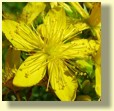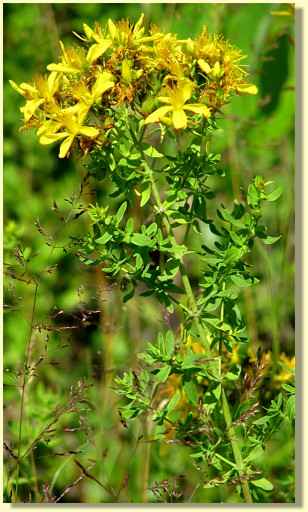
The Biology of St. John's Wort (Hypericum perforatum)St. John's Wort (H. perforatum) is a herbaceous (non-woody) plant that belongs to the family Clusiaceae, one of nearly 400 species of Hypericum known worldwide. It is considered to be an invasive alien species in Manitoba and classed as a noxious weed. St. John's Wort was introduced from Europe around 1700 and has spread throughout much of North America. In the plant's native range in Europe it has been used medicinally since at least ancient Greek times. (Click thumbnail images to see larger images.) Description
Life Cycle
HabitatSt. John's Wort grows in a variety of conditions, but prefers sunny, well-drained soils. It can tolerate a little shade, but will not persist in deep shade. In Manitoba this plant is found throughout the southern agricultural zone and may be spreading into boreal forest regions along roadsides. ClassificationHere's the formal classification of St. John's Wort:
Name
The word "wort" is an old English term for a non-woody plant, a herb or forb. (Another meaning of "wort" is a liquid which can be fermented to make beer or whiskey.) It's a corruption of the Old English "wyrt", Anglo-Saxon for “useful pot-herb.” The St. John's part of the common name is thought to derive from its association with the Feast of St. John (John, the Baptist). It blooms starting in late June, around the time of the Feast of St. John and this was when the plants were harvested and prepared for medicinal use. Prior to Christianity taking hold in northern Europe these plants, with their bright yellow flowers and habit of blooming near the solstice, were linked with the sun god, Baldur. Festivals honouring the sun god, celebrated around the summer solstice, were co-opted by early Christians and renamed to honour John the Baptist. (Another example of "you can change who a people pray to, but don't mess with the timing of a great party!" See Origins of the Christmas Tree in the NatureNorth article on Black Spruce.) The genus name, Hypericum, comes from the Greek words hyper (above) and eikon (picture). Traditionally, to ward off evil, this plant was hung over a picture or icon. The species name, perforatum, is Latin for "perforated", referring to translucent dots of the leaves. UsesWhat hasn't this plant been used for! The flowers and upper stems of the plant were harvested, dried and ground up for use in teas, tinctures or to extract the essential oils. These were used varyingly for external treatment of ulcers, wounds, cuts and bruises. Teas were prescribed for bladder ailments, depression, dysentery, diarrhea, and worms; as a tonic for the liver and gallbladder and even to relieve symptoms of menopause. In England it was used to cure insanity, in Russia to cure rabies and in Brazil as a cure for snake bite. It is even attractive to rats and rumored to have been used by the Pied Piper to lure rats out of Hamelin. (There are some truly wild claims out there for the powers of St. John's Wort!) Modern research has shown that the various compounds in St. John's Wort have real efficacy in the treatment of depression, as an antibiotic and an anti-inflammatory. The main common use of this plant is as an anti-depressant.
Active CompoundsSt. John's Wort is known to include a veritable cornucopia of active compounds including: hypericin, flavonoids, glycosides, tannins, essential oils, bioflavones, pseudohypericin, and volatile oils. The hypericin and pseudohypericin are thought to be the most important compounds with respect to treating depression. Commercial ProductionSt. John's Wort is grown as a commercial crop in parts of Europe and North America, all the while being considered a noxious weed in more than 20 countries! With the recent resurgence in its medicinal use there is a significant market for this plant. Check out this Government of Saskatchewan website: St. John's Wort for some great info on commercial production of this plant. They claim yields of up to 1 ton/acre (2.5 tonnes/ha) dry weight have been reported for this crop in Saskatchewan. At a price of about $13/kg that could mean over $30,000 per ha! That's some pricey weeds! Make Your Own?Purchasing St. John's Wort can be pricey, 100 capsules or 1 oz of oil can cost you $10! If you are determined to grow or harvest your own St. John's Wort be aware of local weed control laws. You could be fined for having it on your property. There are registered strains that can be purchased online, or you could make use of plants you find in the wild. Sadly, they are not hard to find in many parts of Manitoba. The plants are best harvested when they are in full flower. Cut the tops of the plants including the flowers. Place the cuttings in a cool dry place. When they are dry and crisp to the touch they can be ground up for use. How and whether to use this product is up to you. Please read the next section! Use With Caution!Just because something is natural, doesn't mean it can't hurt you! Think: hemlock and rattlesnakes! If you're self-medicating with St. John's Wort be careful and find out about the potential interactions of the chemicals it contains with other substances you may be taking. St. John's Wort interacts with a wide variety of prescription medications and can even reduce effectiveness of birth control pills! Please, consult your doctor. Noxious WeedIn Manitoba, St. John's Wort is considered a noxious weed, partly because of its aggressive nature and its displacement of native species, but primarily because it has toxic effects on cattle and other grazers. It can cause photosensitization (excess reaction to bright light causing skin irritation), central nervous system depression, spontaneous abortion, and even death. In parts of North America biological control efforts for St. John's Wort have begun involving the use of several species of European beetles (Chrysolina spp.) that eat the plants. Final ThoughtsSt. John's Wort is a plant with a storied history. It is a great example of how people can turn to nature to find useful chemicals and medicines. But it is also an example of how people have damaged many parts of the world by releasing a species into habitats where it doesn't belong. We have so much to learn from nature, if we can just stop wrecking it as we go along. - Johnny Caryopsis - If you enjoyed this article you might also like: Our Purple Coneflower | Giant Hyssop | Summer Fruits | Poison Ivy Recommended ReadingsThere is tons of information out there on St. John's Wort. Some good websites to visit are: St. John's Wort - Wikipedia | St. John's Wort - NCCAM | St. John's Wort - Saskatchewan
|
Return to: St. John's Wort | Summer Issue | NatureNorth Front page


 St.
John's Wort is also known as hypericum, Klamath weed, goat weed, or
Tipton's Weed, though some of these names may apply to other related
plants in the same genus.
St.
John's Wort is also known as hypericum, Klamath weed, goat weed, or
Tipton's Weed, though some of these names may apply to other related
plants in the same genus.